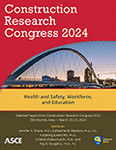Do Projects of Different Sizes Face Differences in Safety-Critical Complexities? Empirical Evidence from Implications for the Construction Sector of India
Publication: Construction Research Congress 2024
ABSTRACT
The existing literature emphasizes developing safety recommendations specific to small, medium, and large construction projects’ unique needs. Research has also shown that enhanced complexities can negatively affect the safety performance of construction projects. However, whether projects of different sizes perceive complexities differently has not been examined empirically in the existing literature. To address the gap, the current study examines how differently sized construction projects perceive the technical, organizational, and environmental complexities while managing safety. An existing survey was adapted, and 180 responses were obtained from practitioners across small, medium, and large construction projects. The findings reveal that most complexities are perceived as critical throughout the industry, and the perception of technical, organizational, and environmental complexities differs within projects of different sizes. The study’s findings significantly advance understanding of the safety-critical complexities confronting projects of varying sizes and aid in developing safety improvement recommendations tailored to their specific needs.
Get full access to this article
View all available purchase options and get full access to this chapter.
REFERENCES
Ammar, A., Al-Shabbani, Z., and Dadi, G. 2002. “Toward a safety culture model for small construction organizations.” Construction research congress 2022 (pp. 356–365).
Barlett, J. E., Kotrlik, J. W., and Higgins, C. C. 2001. “Organizational research: Determining appropriate sample size in survey research.” Information Technology, Learning, and Performance Journal, 19(1), 43–50.
Bosch-Rekveldt, M., Jongkind, Y., Mooi, H., Bakker, H., and Verbraeck, A. 2011. “Grasping project complexity in large engineering projects: The TOE (Technical, Organizational and Environmental) framework.” Int. J. Project Manage., 29(6), 728–739.doi: https://doi.org/10.1016/j.ijproman.2010.07.008.
Dale, A. M., Colvin, R., Barrera, M., Strickland, J. R., and Evanoff, B. A. 2020. “The association between subcontractor safety management programs and worker perceived safety climate in commercial construction projects.” J. Saf. Res., 74, 279–288. doi: https://doi.org/10.1016/j.jsr.2020.06.010.
Dainty, A. 2008. Methodological pluralism in construction management research. Advanced research methods in the built environment, 1, 1–13.
Dhal, M. 2020. “Labor stand: Face of precarious migrant construction workers in India.” J. Constr. Eng. Manage., 146(6), 04020048. doi: https://doi.org/10.1061/(asce)co.1943-7862.0001761.
Doyle, A., and Hughes, W. P. 2000. The influence of project complexity on estimating accuracy. 16th Annual ARCOM conference, 623–634. http://www.arcom.ac.uk/publications/procs/ar2000-623-634_Doyle_and_Hughes.pdf.
Hair, J. F. 2009. Multivariate data analysis.
Hollnagel, E. 2012. “Coping with complexity: past, present and future.” Cognit. Technol. Work, 14, 199–205. doi: https://doi.org/10.1007/s10111-011-0202-7.
Holt, G. D. 2013. “Asking questions, analysing answers: relative importance revisited.” Constr. Innovation 14(1):2–16. doi: https://doi.org/10.1108/CI-06-2012-0035.
Hwang, B. G., Zhao, X., and Toh, L. P. 2014. Risk management in small construction projects in Singapore: Status, barriers and impact. Int. J. Project Manage., 32(1), 116–124. https://doi.org/10.1016/j.ijproman.2013.01.007.
Legg, S. J., Olsen, K. B., Laird, I. S., and Hasle, P. 2015. “Managing safety in small and medium enterprises.” Saf. Sci. 71(PC):189–96. doi: https://doi.org/10.1016/j.ssci.2014.11.007.
Peñaloza, G. A., Saurin, T. A., and Formoso, C. T. 2020. “Monitoring complexity and resilience in construction projects: The contribution of safety performance measurement systems.” Appl. Ergon., 82, 102978. https://doi.org/10.1016/j.apergo.2019.102978.
Smith, G. R., and Bohn, C. M. 1999. Small to medium contractor contingency and assumption of risk. J. Constr. Eng. Manage., 125(April), 101–108.
Strömbäck, E. 2015. Contract size and small firm competition in public procurement. 2009. http://www.diva-portal.org/smash/record.jsf?pid=diva2%3A849659&dswid=7694.
Trinh, M. T., and Feng, Y. 2020. “Impact of project complexity on construction safety performance: Moderating role of resilient safety culture.” J. Constr. Eng. Manage., 146(2), 04019103. doi: https://doi.org/10.1061/(asce)co.1943-7862.0001758.
Tuli, F. 2010. The basis of distinction between qualitative and quantitative research in social science: reflection on ontological, epistemological and methodological perspectives. Ethiopian journal of education and sciences, 6(1). https://doi.org/10.4314/ejesc.v6i1.65384.
Information & Authors
Information
Published In
History
Published online: Mar 18, 2024
ASCE Technical Topics:
Authors
Metrics & Citations
Metrics
Citations
Download citation
If you have the appropriate software installed, you can download article citation data to the citation manager of your choice. Simply select your manager software from the list below and click Download.
